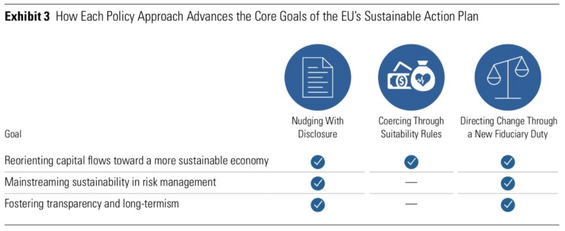European authorities are continuing to push forward with the Sustainable Finance Action Plan despite the coronavirus pandemic. In addition to many individual subcomponents of the plan experiencing new developments, the European Commission has also initiated work on a Renewed Sustainable Finance Strategy.
This policy strategy aims to provide the financial systems the tools needed to transition to the standards outlined by the EU Green Deal. The Green Deal presents a vision for a climate-neutral continent by 2050 and a road map to get there, which includes 50 actions to take by 2050. The renewed strategy is scheduled for adoption in the fourth quarter of 2020 and has been kicked off with a wide-ranging public consultation to build on the 10 steps of the EU Sustainable Finance Action Plan.
In a recent paper, “Regulating ESG Investing the EU Way,” we explored the principal tactics of the Sustainable Finance Action Plan, which at its heart seeks to induce behavioral change to reorient capital flows and mainstream sustainability in risk management. It signified a massive shift in the way governments want financial markets regulated--from emphasizing investor protection to mobilizing investors’ money for a more sustainable future for next generations.
What Will Drive the Effectiveness of Policy Approaches?
While the EU’s specific set of goals to increase sustainable investing is new, the European Commission’s core approaches to advancing the agenda are not.
Historically, the EU has used three tools—Disclosure, Fiduciary Duties, and Suitability—to protect investors and keep markets fair. Used together, these tools intend to induce a variety of third parties to carry out a public aim and fulfill the Plan’s three overarching objectives: to reorient capital flows, mainstream sustainability in risk management, and foster transparency and long-termism. These goals are outlined on the table below. 
In order for the two most coercive of these approaches—the extension of suitability standards and fiduciary duties—to be successful, the new disclosures also need to be effective.
When it comes to integrating ESG factors into recommendations for ordinary investors, financial advisors’ effectiveness will depend on how they work with their clients to draw out their sustainability preferences, and the degree to which product disclosures provide the requisite information to match recommendations with client preferences.
In turn, that detail in product disclosures will depend on the degree to which asset managers integrate ESG factors into their processes and provide products that meet investors’ needs. The final link in the chain of dependencies, which will ensure that each product lives up to its sustainable objectives, is the degree to which investee companies provide reliable and consistent data to asset managers.
Taxonomy and Disclosure Regulations
One foundational piece of the EU Sustainable Finance Action Plan is the Taxonomy Regulation, which will be a vital component in normalizing the environmental sustainability information that flows from companies through asset managers and on to advisors and investors. The final report of the EU Technical Expert Group, published in March 2020, provides these entities with information for the basis of their reporting needs.
Another important aspect of the plan is the new Sustainability-Related Disclosures Regulation, which will apply to firms manufacturing investment products. The first provisions, which require more public sustainability information at the firm level, will take effect on March 10, 2021. More detailed disclosures about each of their products will be required at the end of 2021.
The next two papers in the Morningstar EU Sustainable Finance Action Plan series will unpack these two new major regulations. They will explain the requirements for companies and asset managers as well as detail what they will ultimately provide to investors.


